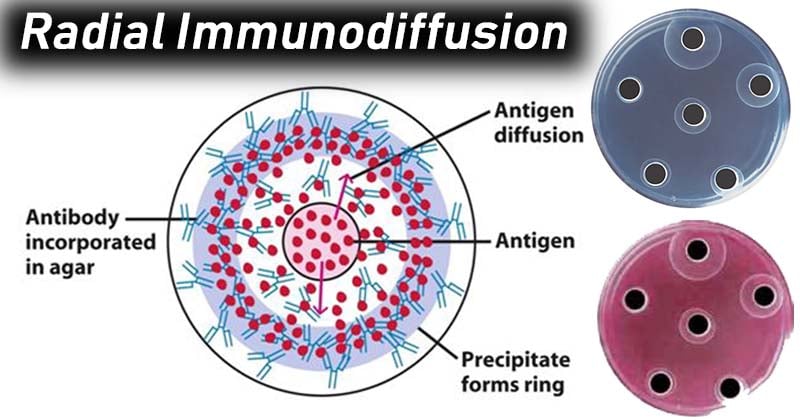Immuno-diffusion is a technique for the detection or measurement of antibodies and antigens by their precipitation which involves diffusion through a substance such as agar or gel agarose. Simply, it denotes precipitation in gel.
It refers to any of the several techniques for obtaining a precipitate between an antibody and its specific antigen.
This can be achieved by:
- a) Suspending antigen/antibody in a gel and letting the other migrate through it from a well or,
- b) Letting both antibody and antigen migrate through the gel from separate wells such that they form an area of precipitation.
Based on the method employed, immuno-diffusion may be:
- Radial immunodiffusion
- Ouchterlony Double Diffusion
Radial immunodiffusion (RID) or Mancini method is also known as Mancini immunodiffusion or single radial immunodiffusion assay. It is a single diffusion technique whereby a solution containing the antigen is placed into wells in a gel or agar surface evenly impregnated with antibody. The diameter of the ring that precipitates around the well as a result of antigen antibody reaction corresponds to the amount of antigen in the solution.
Interesting Science Videos
Objectives of Radial Immunodiffusion
The Mancini immunodiffusion test may be carried out with one or more of the following objectives:
- To detect antigen-antibody complexes.
- Describe the circumstances under which antigen-antibody complexes precipitate out.
- Determine relative concentration of antigens.
Principle of Radial Immunodiffusion
Radial immuno-diffusion is a type of precipitation reaction. It is thus based on the principles of the precipitin curve which states that antigen-antibody interact forming visible cross-linked precipitate when the proper ratio of antigen to antibody is present. In the test, antibody is incorporated into agar and poured into a glass plate to form a uniform layer. Circular wells are cut into the agar and antigen is introduced into the wells. Specific antigens to the impregnated antibodies diffuse through the agar in all directions from the well and react with the antibody present forming visible precipitate or a precipitin ring. Ring shaped bands of precipitates from concentrically around the well indicating reaction. The diameter of the precipitate ring formed, corresponds to the amount of antigen in the solution.
Procedure of Radial Immunodiffusion
- An agar containing an appropriate antiserum (antibody) is poured in plates.
- Carefully circular wells are cut and removed from the plates.
- A single or series of standards containing known concentration of antigen are placed in separate wells, while control and “unknown” samples are placed in other remaining wells.
- As the antigen diffuses radially, a ring of precipitate will form in the area of optimal antigen – antibody concentration.
- The ring diameters are measured and noted.
- A standard curve is prepared using the ring diameters of the standards versus their concentrations. This curve is then used to determine the concentration of the control and unknown samples.
Result Interpretation of Radial Immunodiffusion

- The presence of a precipitin ring around the antigen wells indicate specific antigen-antibody interaction.
- Absence of precipitin ring suggest absence of reaction.
- The greater the amount of antigen in the well, the farther the ring will form from the well.
Applications of Radial Immunodiffusion
- Immuno-diffusion techniques are mostly used in immunology to determine the quantity or concentration of an antigen in a sample.
- Estimation of the immunoglobulin classes in sera.
- Estimation of IgG, IgM antibodies in sera to influenza viruses.
Other applications include:
- To determine relative concentrations of antibodies in serum.
- Estimate serum transferrin and alpha-feroprotein.
- To compare properties of two different antigens.
- To determine the relative purity of an antigen preparation
- For disease diagnosis
- Serological surveys
Advantages of Radial Immunodiffusion
- Precipitation in gels is believed to provide more specific and sensitive results than other methods available.
- The reaction is in the form of bands of precipitation and can be stained for better viewing as well as preservation.
- If a large number of antigens are present, each antigen-antibody reaction will give rise to a separate line of precipitation.
- This technique also indicates identity, cross reaction and non identity between different antigens.
Limitations of Radial Immunodiffusion
- Long reaction time (18-48 hours)
- It has also been proposed that the results of Mancini’s test is influenced by the presence bound metal cations in the test samples (protein).
- Single diffusion menthod of precipitation is considered relatively wasteful than other methods.
- The test has been recently replaced by more sensitive and automated methods, such as nephelometry and enzyme-linked immunosorbent assays.
References
- Stephan E. Ritzmann; Radial Immunodiffusion Revisited. Part 1, Laboratory Medicine, Volume 9, Issue 7, 1 July 1978, Pages 23–34.
- https://www.slideshare.net/prashanthkumarguddeti/antigen-antibody-interactions-63139960
- Lydyard, P.M., Whelan,A.,& Fanger,M.W. (2005).Immunology (2 ed.).London: BIOS Scientific Publishers.
- Parija S.C. (2012). Textbook of Microbiology & Immunology.(2 ed.). India: Elsevier India.

thanks
Thanks
This is very help full.., well simplified.
I find this article very understandable. My question is 2 pronged. First, as you suggested the so called antigen in well can be an antibody too, IgG, IgA, IgM and so on, while the corresponding ab in this instance would be be the antibody to this antibody, per se, correct? and so on. Otherwise, how would you estimate any antibodies, semi quantitatively using this RID methodology any other way? I await your kind response.
The immunoglobulins (IgG, igM and IgA) are being measured as antigens, not as antibodies. The antibody in these commercial kits is an anti-human immunoglobulin that’s Fc specific.
Thanks
Many thanks for the comprehensive, valuable and easy to understand information
Thank you. This was very helpful.
beyond helpful, thanks a lot
Nice .Very helpful.Shall i share the diaram in my presentation with u r name
Thanks, Sure you can.
thank you so much for your great effort